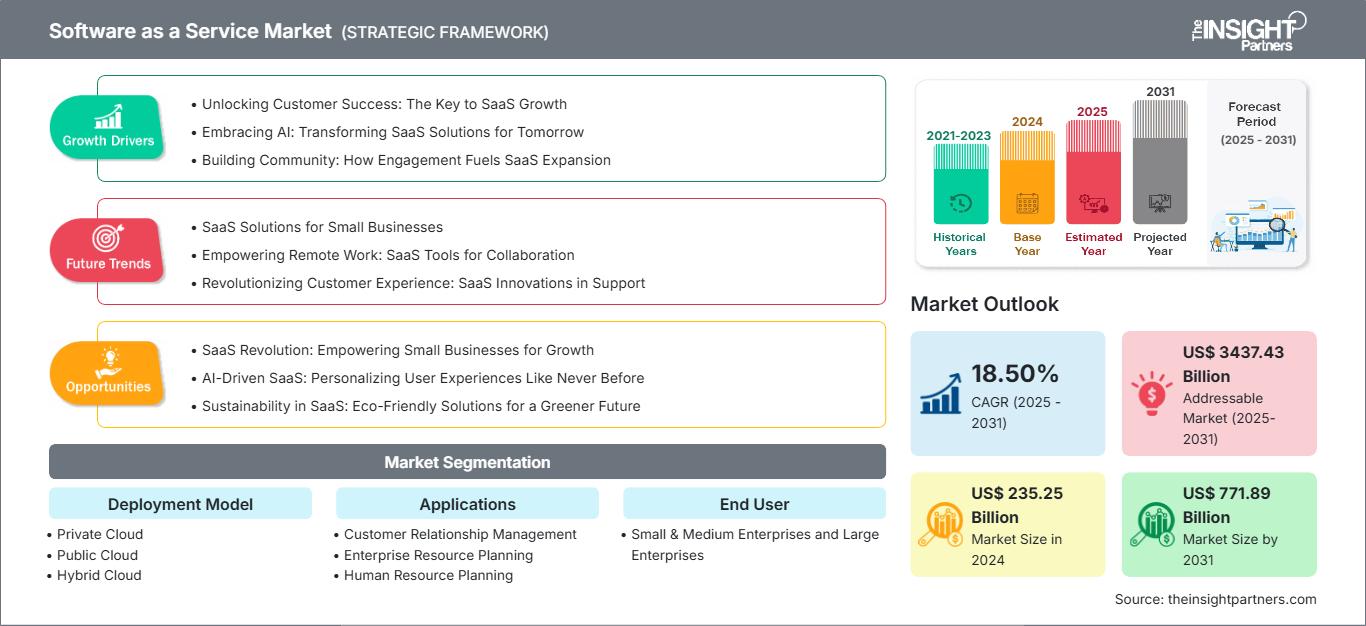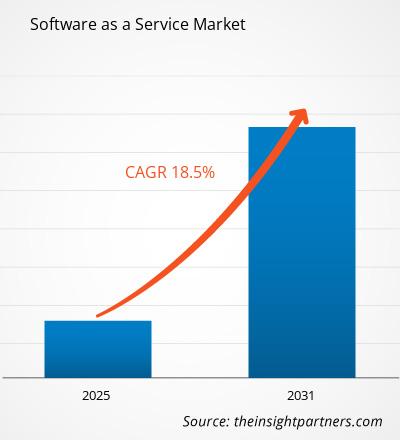Der Markt für Software as a Service (SaaS) wird bis 2031 voraussichtlich ein Volumen von 1235,34 Milliarden US-Dollar erreichen. Für den Zeitraum 2025–2031 wird ein jährliches Wachstum von 19,7 % erwartet.
Der Bericht ist nach Bereitstellungsmodell (Private Cloud, Public Cloud, Hybrid Cloud) kategorisiert und analysiert den Markt zudem anhand von Anwendungen (Customer Relationship Management, Enterprise Resource Planning, Human Resource Planning, Supply Chain Management). Darüber hinaus wird der Markt nach Endnutzern (KMU und Großunternehmen) untersucht. Für jedes dieser Schlüsselsegmente wird eine detaillierte Aufschlüsselung auf globaler, regionaler und Länderebene bereitgestellt. Der Bericht enthält Marktgrößen und Prognosen für alle Segmente, angegeben in US-Dollar. Der Bericht liefert zudem wichtige Statistiken zum aktuellen Marktstatus führender Akteure sowie Einblicke in vorherrschende Markttrends und neue Chancen.
Zweck des Berichts
Der Bericht „Software as a Service Market“ von The Insight Partners beschreibt die aktuelle Marktlage und das zukünftige Wachstum, die wichtigsten Treiber, Herausforderungen und Chancen. Er bietet Einblicke für verschiedene Akteure im Markt, darunter:
- Technologieanbieter/Hersteller: Um die sich entwickelnde Marktdynamik zu verstehen und potenzielle Wachstumschancen zu erkennen, können sie fundierte strategische Entscheidungen treffen.
- Investoren: Um eine umfassende Trendanalyse hinsichtlich Marktwachstumsrate, Finanzprognosen und Chancen entlang der Wertschöpfungskette durchzuführen.
- Regulierungsbehörden: Um Richtlinien zu regulieren und Aktivitäten auf dem Markt zu überwachen, mit dem Ziel, Missbrauch zu minimieren, das Vertrauen der Investoren zu wahren und die Integrität und Stabilität des Marktes zu gewährleisten.
Marktsegmentierung und Bereitstellungsmodell für Software as a Service
- Private Cloud
- Öffentliche Cloud
- Hybrid Cloud
Anwendungen
- Kundenbeziehungsmanagement
- Unternehmensressourcenplanung
- Personalplanung
- Lieferkettenmanagement
Endnutzer
- Kleine und mittlere Unternehmen sowie Großunternehmen
Sie erhalten kostenlos Anpassungen an jedem Bericht, einschließlich Teilen dieses Berichts oder einer Analyse auf Länderebene, eines Excel-Datenpakets sowie tolle Angebote und Rabatte für Start-ups und Universitäten.
Software-as-a-Service-Markt: Strategische Einblicke

- Holen Sie sich die wichtigsten Markttrends aus diesem Bericht.Dieses KOSTENLOSE Beispiel umfasst Datenanalysen, die von Markttrends bis hin zu Schätzungen und Prognosen reichen.
Wachstumstreiber des Software-as-a-Service-Marktes
- Kundenerfolg sichern: Der Schlüssel zum SaaS-Wachstum
- KI nutzen: SaaS-Lösungen für die Zukunft transformieren
- Community-Aufbau: Wie Engagement die SaaS-Expansion fördert
Zukunftstrends des Software-as-a-Service-Marktes
- SaaS-Lösungen für kleine Unternehmen
- Remote-Arbeit ermöglichen: SaaS-Tools für die Zusammenarbeit
- Kundenerlebnis revolutionieren: SaaS-Innovationen zur Unterstützung
Marktchancen des Software-as-a-Service-Marktes
- SaaS-Revolution: Wachstum für kleine Unternehmen
- KI-gesteuertes SaaS: Benutzererlebnisse wie nie zuvor personalisieren
- Nachhaltigkeit in SaaS: Umweltfreundliche Lösungen für eine grünere Zukunft
Software as a Service Markt
Die regionalen Trends und Einflussfaktoren auf den Markt für Software-as-a-Service (SaaS) im gesamten Prognosezeitraum wurden von den Analysten von The Insight Partners ausführlich erläutert. Dieser Abschnitt behandelt außerdem die Marktsegmente und die geografische Verteilung des Marktes für das Management von Herzrhythmusstörungen in Nordamerika, Europa, dem asiatisch-pazifischen Raum, dem Nahen Osten und Afrika sowie Süd- und Mittelamerika.
Umfang des Marktberichts zu Software as a Service
| Berichtsattribut | Einzelheiten |
|---|---|
| Marktgröße in 2024 | US$ XX Billion |
| Marktgröße nach 2031 | US$ 1235.34 Billion |
| Globale CAGR (2025 - 2031) | 19.7% |
| Historische Daten | 2021-2023 |
| Prognosezeitraum | 2025-2031 |
| Abgedeckte Segmente |
By Bereitstellungsmodell
|
| Abgedeckte Regionen und Länder | Nordamerika
|
| Marktführer und wichtige Unternehmensprofile |
|
Dichte der Marktteilnehmer im Software-as-a-Service-Markt: Auswirkungen auf die Geschäftsdynamik
Der Markt für Software as a Service (SaaS) wächst rasant, angetrieben durch die steigende Nachfrage der Endnutzer. Gründe hierfür sind unter anderem sich wandelnde Verbraucherpräferenzen, technologische Fortschritte und ein wachsendes Bewusstsein für die Vorteile des Produkts. Mit steigender Nachfrage erweitern Unternehmen ihr Angebot, entwickeln innovative Lösungen, um den Kundenbedürfnissen gerecht zu werden, und nutzen neue Trends, was das Marktwachstum zusätzlich beflügelt.

- Holen Sie sich die Software-as-a-Service-Markt Übersicht der wichtigsten Akteure
Wichtigste Verkaufsargumente
- Umfassende Abdeckung: Der Bericht bietet eine umfassende Analyse der Produkte, Dienstleistungen, Typen und Endnutzer des Software-as-a-Service-Marktes und vermittelt so ein ganzheitliches Bild.
- Expertenanalyse: Der Bericht basiert auf dem fundierten Wissen von Branchenexperten und Analysten.
- Aktuelle Informationen: Der Bericht gewährleistet Geschäftsrelevanz durch die Berücksichtigung aktueller Informationen und Datentrends.
- Anpassungsmöglichkeiten: Dieser Bericht kann an spezifische Kundenanforderungen angepasst werden und sich optimal in die Geschäftsstrategien integrieren.
Der Forschungsbericht zum Software-as-a-Service-Markt kann somit maßgeblich dazu beitragen, das Branchenszenario und die Wachstumsaussichten zu entschlüsseln und zu verstehen. Auch wenn einige berechtigte Bedenken bestehen, überwiegen die Vorteile dieses Berichts insgesamt die Nachteile.
- Historische Analyse (2 Jahre), Basisjahr, Prognose (7 Jahre) mit CAGR
- PEST- und SWOT-Analyse
- Marktgröße Wert/Volumen – Global, Regional, Land
- Branchen- und Wettbewerbslandschaft
- Excel-Datensatz
Aktuelle Berichte
Verwandte Berichte
Erfahrungsberichte
Grund zum Kauf
- Fundierte Entscheidungsfindung
- Marktdynamik verstehen
- Wettbewerbsanalyse
- Kundeneinblicke
- Marktprognosen
- Risikominimierung
- Strategische Planung
- Investitionsbegründung
- Identifizierung neuer Märkte
- Verbesserung von Marketingstrategien
- Steigerung der Betriebseffizienz
- Anpassung an regulatorische Trends






















 Kostenlose Probe anfordern für - Software-as-a-Service-Markt
Kostenlose Probe anfordern für - Software-as-a-Service-Markt